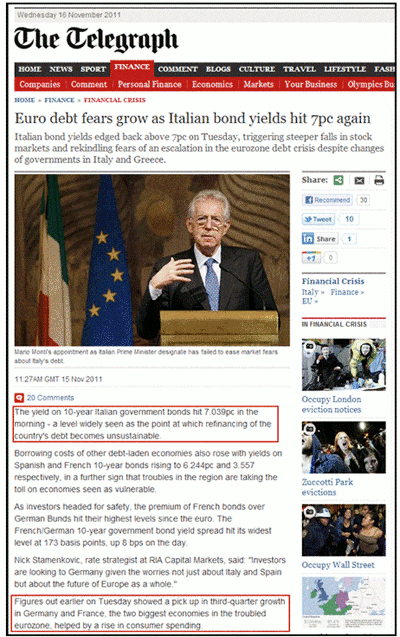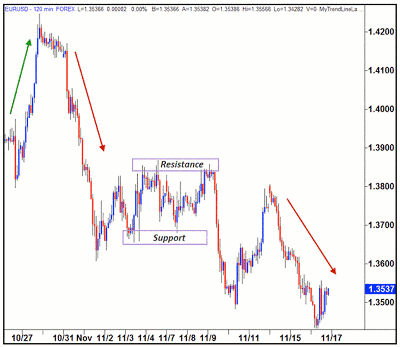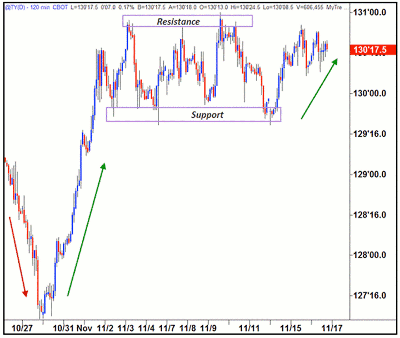While inexperienced traders can sustain big losses trying to trade around the day’s news and data releases, there are some lower-risk news-driven opportunities as well, especially in the current markets.
Okay, I finally confess to you all: I love trading forex on the news!
If you are reading this statement and are a student of mine or familiar with my previous articles, you may actually be thinking that I have been pulling the wool over your eyes up until this very point due to the fact that I have spoken time and time again about how I keep my trading simple by just objectively following the imbalances in supply and demand on my technical price charts.
See related: It All Starts with Supply and Demand
Well, I can assure you this is very much still the case, and I highly doubt that it will ever change as long as I am trading the financial markets. However, just because I make my trading and investing decisions upon a simple set of technical rules does not mean that I ignore the news altogether.
In fact, as of late, I have been factoring the news and current fundamental outlook into my daily trading activities even more than ever, but not in the way you would probably think. Let me explain more.
In all honesty, my opening statement about loving the news was slightly in jest. I would never advise any novice or even veteran trader to attempt to trade the news. In that, I mean when major economic announcements like non-farm payrolls are made, or Fed statements are released to the general public.
See related: Why Traders Should Ignore the News
Trying to interpret the data or figure releases as they come out can easily result in trading suicide if you are not careful. However, I have found that if you are truly objective in your analysis and only select the highest-probability trading opportunities that offer the best risk/reward profiles, then trading around the news releases can be quite a rewarding experience.
I also like to pay attention to some key aspects of fundamental analysis when I trade, but moreso in a method which allows me to use fundamentals in a technical manner. There are some unique relationships between various markets which can help the disciplined forex trader in many ways, but again, only if they are willing to apply key rules around their daily trading activities.
As we all know, Europe is in a pretty big mess. As much as the European Monetary Union seemed like a good idea at the time when the bulk of European nations gave up their currencies to adopt the Euro, right now, I would like to wage a bet that they don’t quite feel the same enthusiasm for the single currency system as of late.
With the ongoing drama of Greece’s debt worries (which can you believe have been going on for around 18 months now?), fears of contagion spreading across the continent, and general concerns about the prospects of a double-dip global recession, the last thing the markets needed was the news on November 9 that Italy had now joined the growing list of debt-ridden nations.
NEXT: Italian Headlines Roil World Currency Markets
|pagebreak|Concerns were sparked that day by a sharp rally in Italian ten-year bond yields when they broke the key rate of 7%. This, in turn, resulted in a sharp fall of over 300 pips in EUR/USD and a heavy fall in stocks around the world.
We did see the markets bounce back a little the next day, but it seems that there is rarely smoke without a fire, and at the time of writing this article, the same yield levels are being hit once again with reports like this one all over the media:
If you are not a fundamental kind of trader, you may have been asking yourself what this is all about. To the truly uneducated individual, news reports like the one above can be a little scary. “So what if bond yields go up; how does this affect the rest of the markets, especially forex?”
Trust me, if you understand just a little about how bonds work from a fundamental perspective, then they can actually help you if use them in a technical manner.
All we really need to understand is that a bond, like a US ten-year Treasury note (one of the most popular bonds in the world), is nothing more than a loan to a government. If you buy a bond, you are simply lending money to the issuing nation’s government, who in turn will pay you interest over the set period of the loan.
Over time, however, like any other tradable instrument, bond face value prices have become affected by good old supply and demand. A bond for a $10,000 notional value may pay a yield of, say, 5% over a fixed ten-year period, however, the more people out there who want the bond will create demand which is greater than supply.
As we know, this will then push face value prices of the bond higher. People may actually end up paying say $15,000 for the bond when it only had a notional value of $10,000 originally. This in turn affects the bond’s yield because the interest rate is for the fixed sum of $10,000, not $15,000.
Therefore, the higher the face values travel on the bond, the lower yields fall on the same bond because you have to invest more cash for a smaller percentage return on the investment. This inverse relationship occurs also when bond face values fall, which then makes the yields turn higher.
Now that we understand this dynamic, we can see that the reason why Italian bond yields rose so high was because the face value of the bonds was rapidly falling, meaning the market had no confidence in lending money to the Italian government due to their debt issues and in turn decided to offload their bonds, hence pushing yields that much higher.
If we think about this from a logical perspective, it makes perfect sense. If you have confidence in a nation or company, you would be willing to lend money to it. If you did not have confidence in it, you would probably choose to not lend any money. Thus, with confidence in Italy’s financial stability at an all-time low, is it any surprise to see the market selling off the nation’s bonds?
With this in mind, we can look at this bond/sentiment relationship on a price chart.
NEXT: See the Impact on EUR/USD Charts
|pagebreak|In the example below, I have taken a shot of some of the recent trading activity of the EUR/USD in the last few weeks. Notice how it has bounced off support and resistance levels, as well as going through both periods of rallies and falls:
At the very same time, I want to also look at a price chart of the US ten-year Treasury note, often seen among large investors and institutions as a true “safe-haven” asset in times of economic uncertainty due to the fact that yields are guaranteed, and while historically weaker, the US dollar is still the world’s primary reserve currency.
Those among you with a keen eye will notice that the above chart is pretty much an inverse image of the same time frame EUR/USD chart. It also went through periods of uptrend and downtrend, as well as enjoying falls and drops from support and resistance levels at exactly the same time.
The simple logic behind this inverse correlation is that when the market feels confident in the euro, it buys it and pulls money out of the safe haven of bonds. When it has cause for concern about the euro, it dumps inventory and money flows back to US bonds.
I am by no means an economist, and I have never been one to allow fundamentals to dictate my trading; however, if you manage to grasp a logical understanding of how and why markets function in reality, the astute trader has many opportunities to stack the odds in their favor when placing a trade.
I don’t know about you, but when I get the signal to pull the trigger in one market, and at the same time, another market that is intrinsically linked to it is telling me the same thing, I always feel better about taking the opportunity.
I hope this was useful.
By Sam Evans, instructor, Online Trading Academy
























